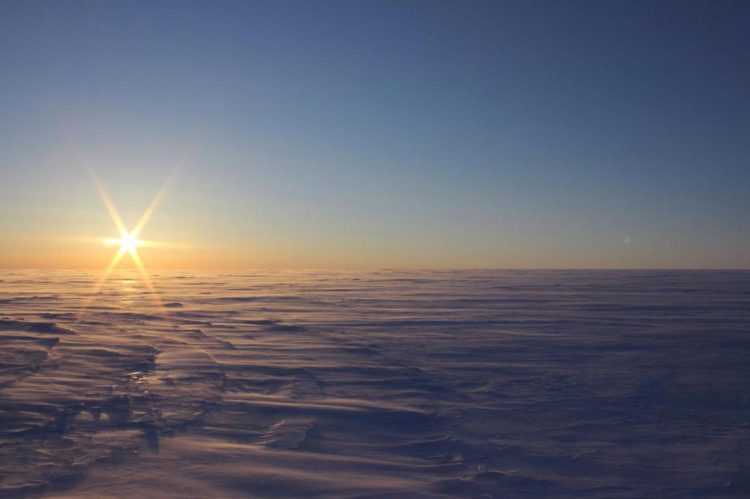Newly discovered salty subglacial lakes could help search for life in solar system

A cold and windy spring night on the vast landscape of Devon Ice Cap where two subglacial lakes are lurking 750 meters below the surface. Credit: Anja Rutishauser
The two new lakes are a potential habitat for microbial life and may assist scientists in the search for life beyond Earth. The findings, published in the April 13 edition of Science Advances, were made possible by airborne radar data acquired by UTIG and NASA and represent a new collaboration between Canada and the United States. Lead author Anja Rutishauser is a Ph.D. student at the University of Alberta who will join The University of Texas at Austin as a postdoctoral fellow when she finishes her degree.
While there are more than 400 known subglacial lakes in the world, concentrated primarily in Antarctica with a few in Greenland, these are the first found in the Canadian Arctic. And unlike all the others–which are believed to contain freshwater–these two appear to consist of extremely salty water. All subglacial lakes are good analogues for life beyond Earth, but the hypersaline nature of the Devon lakes makes them particularly tantalizing analogues for ice-covered moons in our solar system, researchers said.
In 2011, researchers from UTIG showed that Jupiter's icy moon Europa, likely contains hypersaline lakes of liquid water within an ice shell that floats atop of a global ocean. The new lakes observed in Canada are very similar to these potential lakes locked inside Europa's icy shell. An analysis of radar data, show that the lakes discovered in Canada are located beneath 550 to 750 meters of ice underneath the Devon Ice Cap, one of the largest ice caps in the Canadian Arctic. They are thought to be the first isolated hypersaline subglacial lakes in the world, having no contact with an outside environment for thousands of years.
“If there is microbial life in these lakes, it has likely been under the ice for at least 120,000 years, so it likely evolved in isolation,” Rutishauser said. “If we can collect a sample of the water, we may determine whether microbial life exists, how it evolved, and how it continues to live in this cold environment with no connection to the atmosphere.”
By evaluating the airborne survey data and, eventually, samples from the lake, scientists can better prepare for NASA's forthcoming Europa Clipper mission, which plans to deploy similar remote sensing techniques to characterize Europa's ice shell, said co-author Donald Blankenship, a UTIG senior research scientist. Blankenship is leading the development of the ice penetrating radar sounder for the Clipper mission, an instrument very similar to the one used to discover the Canadian lakes.
Researchers with Montana State University, Stanford University, and the Cambridge University Scott Polar Research Institute also worked on the project. In addition to Blankenship, UTIG researchers Jamin Greenbaum, Cyril Grima and Duncan Young worked on the study. UTIG is a research unit of the UT Jackson School of Geosciences. The same research team is currently planning a return to the Canadian Arctic in spring 2018 for additional data acquisition over the lake area and surrounding ice caps with support from Canada's W. Garfield Weston Foundation.
“It's amazing how the trilateral collaboration between Canadian, U.S. and UK universities to understand ice cap response to climate change evolved into a paradigm shift in our perspective on potential terrestrial analogs for extraterrestrial habitats,” Blankenship said.
###
UTIG's data acquisition and processing were supported by NASA's Instrument Concepts for Europa Exploration Program, the G. Unger Vetlesen Foundation and the National Science Foundation; additional data used in the research were acquired by NASA's Operation Icebridge Mission. Blankenship was supported by the Fulbright Scholar Program for data interpretation and synthesis activities. The project was supported by the Natural Sciences and Engineering Research Council of Canada, Alberta Innovates Technology Futures, the CRYSYS Program (Environment Canada), and the UK Natural Environment Research Council.
Media Contact
More Information:
https://www.eurekalert.org/pub_releases/2018-04/uota-nds040918.phpAll latest news from the category: Earth Sciences
Earth Sciences (also referred to as Geosciences), which deals with basic issues surrounding our planet, plays a vital role in the area of energy and raw materials supply.
Earth Sciences comprises subjects such as geology, geography, geological informatics, paleontology, mineralogy, petrography, crystallography, geophysics, geodesy, glaciology, cartography, photogrammetry, meteorology and seismology, early-warning systems, earthquake research and polar research.
Newest articles

Pinpointing hydrogen isotopes in titanium hydride nanofilms
Although it is the smallest and lightest atom, hydrogen can have a big impact by infiltrating other materials and affecting their properties, such as superconductivity and metal-insulator-transitions. Now, researchers from…

A new way of entangling light and sound
For a wide variety of emerging quantum technologies, such as secure quantum communications and quantum computing, quantum entanglement is a prerequisite. Scientists at the Max-Planck-Institute for the Science of Light…

Telescope for NASA’s Roman Mission complete, delivered to Goddard
NASA’s Nancy Grace Roman Space Telescope is one giant step closer to unlocking the mysteries of the universe. The mission has now received its final major delivery: the Optical Telescope…



